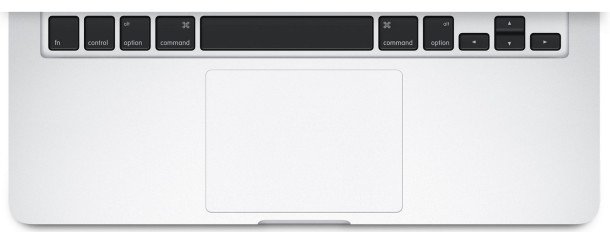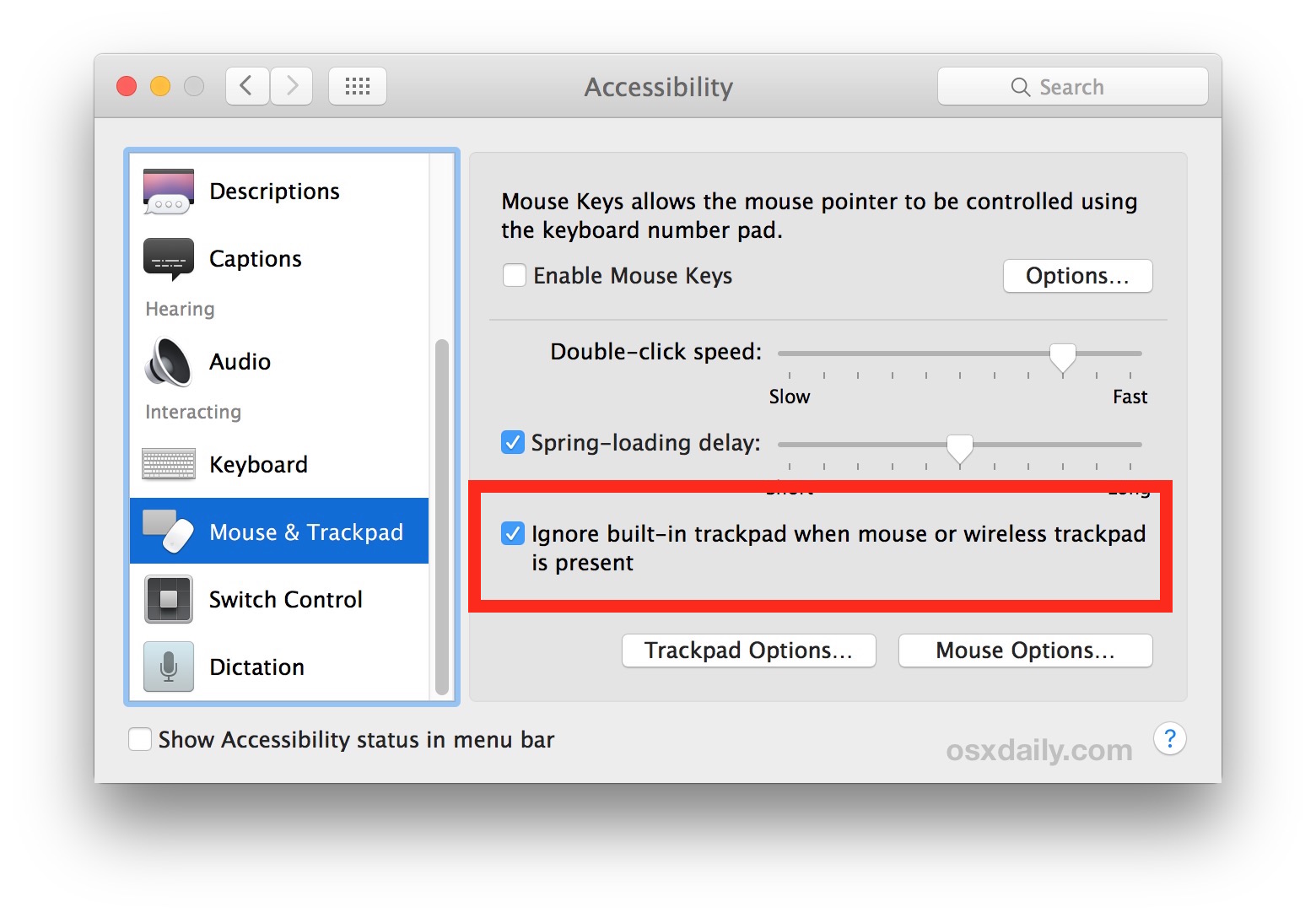Ignoring Built-in Trackpad Input When Using External Mouse with MacBook

The built-in trackpad on MacBook Pro and MacBook functions as the primary input method of the Apple laptops, but if you primarily use an external mouse or external trackpad you may occasionally find the built-in trackpad receives input you’d rather the Mac ignore. With a simple settings adjustment you can do exactly that, ignoring any input from the internal built-in trackpad when an external mouse or trackpad is connected to the Mac.
Disable Built-in Trackpad When External Mouse / Trackpad Connected to MacBook
This applies to any MacBook, MacBook Air, or MacBook Pro. Macs without a built-in trackpad will not have this feature.
- From the Apple menu go to “System Preferences” and then choose “Accessibility”
- Select “Mouse & Trackpad” from the Interacting section on the left
- Check the box next to “Ignore built-in trackpad when mouse or wireless trackpad is present”
- Close out of System Preferences

Changes take effect immediately, any external connected mouse whether through Bluetooth or USB will now cause the internal trackpad on a MacBook, macBook Air, or MacBook Pro to be ignored while those external devices are in use and connected.
This can be a great feature for many users for a variety of users, but particularly for Mac owners who don’t use the internal trackpad when an external device is connected anyway. Or perhaps your cat or monkey frequently crawls around on your desk and paws at your trackpad, it would ignore that as well as long as an external pointing device is attached and in use.
Aside from the obvious uses of this as a feature, it can also sometimes function as a reasonable troubleshooting trick if you find that you’re often unable to click because of interference between two different input devices, or you are experiencing other weird cursor and click activity and mouse behavior.
If you have enabled this feature and find it not to be useful, just disable it again through the same settings by unchecking the “Ignore built-in trackpad” option. Similarly, if you find that your internal trackpad is not working seemingly out of the blue while you have an external mouse or trackpad connected to the Mac, check for this setting to see if it’s enabled, that’s probably the reason why.


Thank you! My trackpad has been taking over. Frustrating when I am trying to work. Now I can just use my mouse.
Very useful, thanks!!
It is called Pointer control now.
Settings -> Accessibility -> Pointer Control -> Ignore built-in trackpad when mouse …
Thank me later ;d
THANK YOU!!!!!!!!!!!!!
I have a new macbook air and all instructions found to disable the trackpad do not apply. The preferences for mouse and trackpad as well as accessibility menus have changed. As far as I can tell, disabling the trackpad is no longer possible.
For everyone that can’t get this to work, I found a workaround.
1. Go to System Preferences > Accessibility > Mouse & Trackpad > Options (right of the Enable Mouse Keys checkbox)
2. Check the “Ignore Built-In Trackpad while Mouse Keys is on” checkbox
3. Now, you can toggle whether the trackpad is on by pressing the Option button 5 times.
Except se f yr eys wn’t wr
This DOES NOT work on new MacBook Pro 2018 (USB-C) when using a Bluetooth mouse, I’m using Logitech MX Anywhere 2S and while is doesn’t disable TrackPad it also disconnect once every 3-4 hour for 15 seconds, and every 1-2 days it totally disconnect and only reconnect restore Bluetooth mouse control.
Since Steve Jobs departure, Apple seems to adding large amount of useless features to OSX and iOS (possible all those ideas which was turned down by Jobs or now resurfacing) and Apple products also seems to be lacking quality control (Did Apple hire X-Microsoft programmers?)
Experiencing the same problem with the same mouse.
#MeToo
Looks like the bug is with the Logitech MX Anywhere 2S mouse. I’m on a 2015 MBP 13″ High Sierra and once I started using this particular mouse, the ignore trackpad setting stopped working. I was using a Bluetooth Logitech M557 mouse previously and the ignore trackpad setting worked fine.
I am as well, also my BT on my 15″ MBP cuts out once a day for like 15 seconds for some reason. Quality just isn’t there for Apple anymore like it used to be.
I am an avid Apple user. After much experience with its external Bluetooth devices, I have settled on using an inexpensive Logitech mouse (with easy-to-use USB dongle) as my external tracking device with my MacBook Pro. It’s much more stable than Magic Mouse with no loss of function. The dongle can be used to connect an external Logic (Mac-specific) keyboard at the same time as the mouse, for those who might require a bit more keyboard functionality in a work setting.
Unfortunately, if you run an alternate OS (Windows or Linux) there is no way to disable the touchpad when using a mouse.
Fortunately most Mac users run Mac OS on their Macs.
Too bad for them.
Said no Mac OS user ever…..
Many are having problems with this not remaining set after reboot since Sierra. The latest update dos not fix it either. Hopefully the next update will.
I use a bluetooth Apple mouse. When I wake or start-up my 15″MacBook Pro Retina “confuser”, I have to do this every single time. If I accidentally hit sleep mode by going to the corner which enables it and then have to wake my computer again – once again I have to go through the above procedure. It has never carried over from one wake state to the next. Is there a way to make it permanent?
Would love to know. I do not use my track pad at all. Thanks.